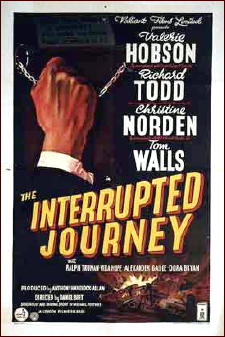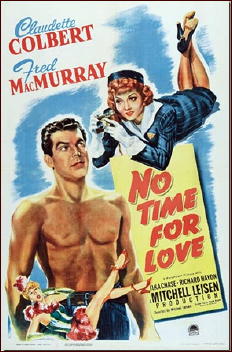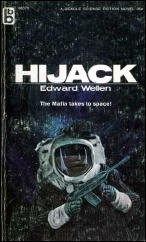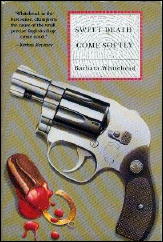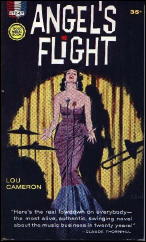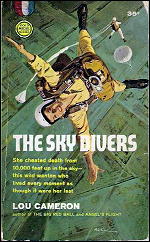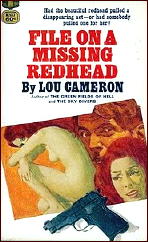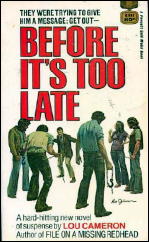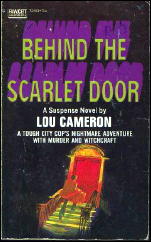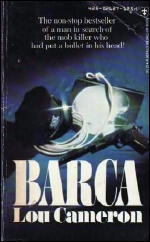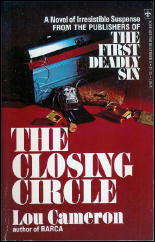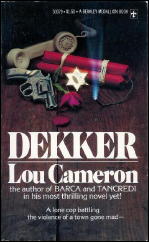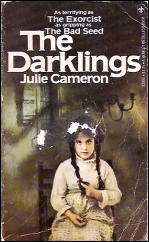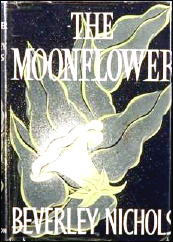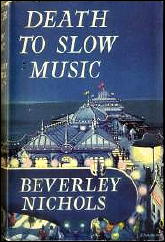March 2011
Monthly Archive
Sat 5 Mar 2011
REVIEWED BY WALTER ALBERT:
QUEEN HIGH. Paramount, 1930. Charlie Ruggles, Frank Morgan, Ginger Rogers, Stanley Smith, Helen Carrington, Rudolph Cameron, Tom Brown. Music arranged by John Green. Director: Fred C. Newmeyer. Shown at Cinefest 28, Syracuse NY, March 2008.
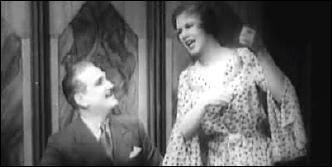
This early sound musical, based on a Broadway musical comedy that co-starred Charlie Ruggles and Frank McIntyre, was adapted for the screen with McIntrye replaced by Frank Morgan, and an enlarged ingenue role for Ginger Rogers.
Morgan and Ruggles are combative partners in a garter-manufacturing business, which is the basis for some naughty dialogue and semi-risque situations in the opening scenes. When the two partners decide to dissolve their relationship, their lawyer devises a plan in which the loser at a game of cards will serve as valet to the other partner for a year, after which the partnership will be dissolved.
Ruggles loses the game and his increasing dissatisfaction with his new role and his attempts to sabotage it fuel the comic situations until it’s all happily resolved. There’s a nicely staged musical number early in the film, but the music is generally incidental to the comedy.
Sat 5 Mar 2011
Posted by Steve under
Reviews[7] Comments
IT IS PURELY MY OPINION
Reviews by L. J. Roberts
KWEI QUARTEY – Wife of the Gods. Random House, US, hardcover, July 2009; trade paperback, August 2010.
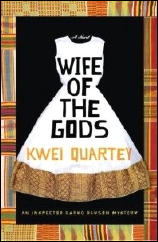
Genre: Police procedural. Leading character: Det. Inspector Darko Dawson; 1st in series. Setting: Ghana, Africa.
First Sentence: The forest was black and Darko was afraid to enter.
DI Darko Dawson is ordered to investigate the murder of a young woman in Kentau, the town from which his mother disappeared many years before. Fighting an incompetent local policeman, Inspector Fiti, superstition and a local priest to whom young women are given as trokosi or wives of the gods, Dawson sets about trying to solve both mysteries and prevent an innocent man from being hanged.
I very much enjoyed this book. On one hand, it is a wonderful look into life in Ghana, which was fascinating; on the other hand it’s a good, solid mystery.
Quartey creates a very strong sense of place whether it be in the town or the small village. We see the customs, even down to the manner of salutations, and superstition, as well as the contrast between lives in the two environments.
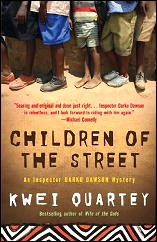
Dawson is well-crafted character. He comes from a family history that is less than ideal, smokes marijuana, although it is illegal, a critically ill son and a difficult relationship with his mother-in-law. Although it wasn’t focused upon, I did wonder whether Dawson has a form of synesthesia from there being a couple mentions of his being able to feel voices.
I appreciated the contrast between Dawson, who uses standard investigative techniques, and Fiti who believes in superstition and forcing a confession to prove his belief. However, I also appreciated there being repercussions for Dawson’s actions, which is unusual.
The story is well plotted and I certainly did not figure out the killer rior to it being revealed. It is wonderful to see more new authors appearing from other countries. I look forward to reading Mr. Quartey’s next book.
Rating: Very Good.
Coming soon: Darko Dawson #2. Children of the Street, Random House, trade ppbk, July 2011.
Fri 4 Mar 2011
REVIEWED BY DAN STUMPF:
INTERRUPTED JOURNEY. British Lion, UK, 1949. Valerie Hobson, Richard Todd, Christine Norden, Tom Walls, Ralph Truman, Vida Hope, Alexander Gauge. Screenplay: Michael Pertwee. Director: Daniel Birt.
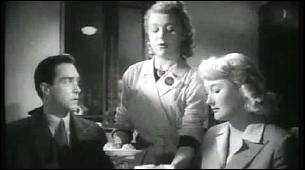
Interrupted Journey is sort of a PG version of Fatal Attraction and a film I recommend to any man thinking of cheating on his wife.
Richard Todd plays a struggling young writer whose wife wants him to get a job. He elects to run off with a wealthy married woman who flatters him, but as they’re preparing to leave he finds himself persecuted by doubts, nagging conscience, and the strange feeling they’re being followed.
They board a train that happens to pass close by his house and, on impulse, he pulls the Emergency Cord, stops the train and flees back to his wife. But then…
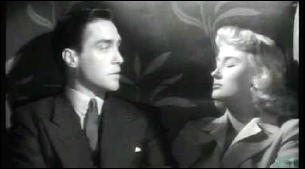
Well, again, it’s one of those films so full of surprising twists that I hate to tell any more. Suffice it to say that the screenwriters turn Todd’s aborted fling into a finely-honed paranoid nightmare, well-played by a bunch of folks I never heard of, and produced with that quiet, comfortable, sumptuous care typical of post-war British films at their best.
There is, incidentally, a scene in Interrupted Journey that caught my attention for reasons I’ll discuss next time: It’s that moment that comes in about every third thriller ever made, where the Hero’s accused of Murder, the Police are coming for him, and he convinces the Heroine (in this case his doubting wife) to hide him.
It’s done here with more intelligence than usual, and a real feeling for the poor wife’s tortured struggle with herself over how far she ought to trust her punic husband.
Fri 4 Mar 2011
REVIEWED BY STAN BURNS:
NO TIME FOR LOVE. Paramount Pictures, 1943. Claudette Colbert, Fred MacMurray, Ilka Chase, Richard Haydn, Paul McGrath, June Havoc, Marjorie Gateson. Director: Mitchell Leisen.
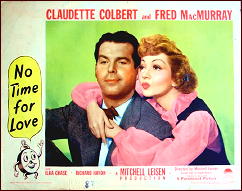
Sandhog Jim Ryan (Fred MacMurray, who is surprisingly buff with his shirt off) is suspended for four months from his job digging a tunnel because of a “friendly” fight with fellow workers that was by happenstance shot by society photographer Katherine Grant (Claudette Colbert).
Because the picture was run by her jealous boyfriend in his magazine (without her knowledge and against her wishes), and its publication led to Ryan’s job loss, Katherine feels responsible and hires Ryan to assist her while he is suspended for four months — which turns into a disaster as he clashes with her on all of her assignments, including picking a fight with a body builder she is try to photograph.
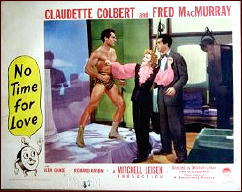
The two are the perfect mismatched pair: she is elegant and refined, and he thinks all her friends are stuck-up jerks and chases after blond floozies. Obviously they are going to fall in love.
A few good lines, but mostly the movie is carried by the charm of the lead actors. The underground tunnel set is very well created and the movie was deservedly nominated for an Oscar for Art Direction. The actors must have loved working in all that mud!
Definitely worth a look, but MacMurray and Colbert are much better paired in The Egg and I.
Rating: B.
Fri 4 Mar 2011
When present day critics and historians look back at the Golden Age of Detection as it took shape in its British form, they almost never go beyond the four “Mystery Queens” of the era: Christie, Sayers, Allingham and Marsh.
Curt Evans, a frequent guest blogger here on Mystery*File, accepts all four as “royalty,” but as you will know from his reviews and his followup comments on the reviews of others, he is a devoted champion of the male authors of the same time period, now deposed and all but relegated to the dustbins of the past.
In this regard, may I recommend to you a two part part series on The American Culture website, in which Curt takes on the present day one-sided view of the past? Names are named, and claims that have been made are hung up for inspection, analyzed and rejected.
And who are the Crime Kings of the era? Curt will tell you. His two-part essay is long, but it’s well worth your time and consideration.
http://stkarnick.com/culture/2011/03/01/the-british-golden-age-of-detections-deposed-crime-kings-part-1-of-2/
http://stkarnick.com/culture/2011/03/03/the-british-golden-age-of-detection%E2%80%99s-deposed-crime-kings-part-2-of-2/
Thu 3 Mar 2011
Posted by Steve under
Reviews[6] Comments
GEORGE BAGBY – I Could Have Died. Doubleday Crime Club, hardcover, 1979.
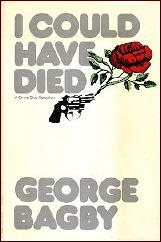
I find the stories that “Bagby” tells us about the exploits of Inspector Schmidt of New York City Homicide about as fast and easy to devour as a fresh batch of hot, buttered popcorn. And he must write them at just about the same rate — after all, this does make seven now that have appeared in just the last three years.
It doesn’t actually begin as a case of homicide. Following the kidnapping of Bagby and two lady companions as part of a successful hotel robbery, quite inexplicably the younger of the two ladies finds herself falling in love with one of her captors. And of course a murder eventually occurs.
There are a few too many holes for the engagingly pleasant and witty plot that results to hold up well under close observation, but in all honesty it also very nearly works the way it’s supposed to.
— Reprinted from The MYSTERY FANcier, Vol. 3, No. 5, Sept-Oct 1979. This review also appeared earlier in the Hartford Courant. Very slightly revised.
[UPDATE] 03-03-11. I’m going to suggest this book to Patti Abbott for inclusion in tomorrow’s weekly roundup of Forgotten Friday mystery novels on her blog. I don’t believe that George Bagby — in real life Aaron Marc Stein, under which name he wrote an equally long list of other detective novels — got nearly the critical attention that I always thought he should have, and he’s definitely forgotten by all but a few devoted aficionados now.
Perhaps he was too prolific, and maybe the endings didn’t match the cleverness of other writers’ mysteries (nor perhaps the openings of his own books), but I always admired the way he had for descriptive passages, making the most prosaic actions — such as taking the cap off a toothpaste tube or hunting for a set of lost keys — seem interesting.
George Bagby, by the way, if the review wasn’t quite clear on this, was both the pen name and the character in the Bagby novels who tagged along with Inspector Schmidt and chronicled his cases for him.
Thu 3 Mar 2011
Posted by Steve under
Reviews[2] Comments
Reviewed by DAVID L. VINEYARD:
JOSEPH FINDER – Vanished. St. Martin’s Press, hardcover, August 2009; reprint paperback, August 2010.
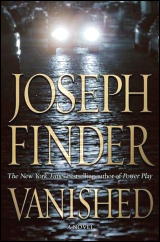
Vanished is the first book in a new series by a writer who specializes in financial intrigue, and who has written several best selling roman a clef’s (The Moscow Club, Power Play) that benefited by prefiguring events that made the headlines across the world, and made his debut with a controversial non-fiction work, The Red Carpet, that exposed the ties of the KGB to American entrepreneur Armand Hammer..
Vanished introduces Finder’s first continuing character, Nick Heller, chief investigator and trouble shooter for Stoddard International and Jay Stoddard, its CEO. Heller is an ex-Special Forces type (de rigueur in today’s thrillers) replete with personal demons and a tough no-nonsense approach to his work.
If that echoes many of the heroes in today’s thriller fiction, what separates Finder from the pack is that he both can really write, and his plots dealing with corporate intrigue have the ring of truth.
The glamour of big business and ruthless corporate back fighting is nothing new in thrillers. John D. MacDonald frequently used shady business as a background in this thrillers as did Hammond Innes, and as have many writers including Michael Thomas, Thomas Gifford, and more recently Christopher Reich. For that matter Emma Lathen’s John Putnam Thatcher series gave us a banker sleuth in that cut-throat world — albeit with more than a dash of humor.
Heller proves to be a likable and believable protagonist. In his first outing the job he’s on for his boss gets pushed aside when his brother Roger disappears after Roger’s wife Lauren is nearly killed. Roger’s panicked teen age son calls on his uncle.
Nick and Roger have a complicated relationship — dating back to their childhood, and their father who is still in Federal prison for securities fraud and insider trading and has been since Nick was only thirteen. Roger followed in Dad’s footsteps — at least in regard to working in the financial world.
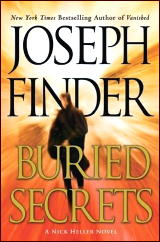
Heller proves a competent guide through the complexities of financial finagling as he pursues his brother — who may not want to be found — as well as a tough no nonsense fighter pitted against a variety of gun-waving types and a ruthless killer known as the Surgeon. Along the way he also grows closer to his nephew, Gabe, who reminds him of himself when confronted with the duplicities of the adult world.
Vanished is a fast read, written in short clipped, staccato chapters and clear prose that is refreshingly free of the jingoism, posing, and diatribes that crowd too many of today’s thrillers.
Finder is satisfied to tell a good story well and let the facts speak for themselves without undue editorializing, while still allowing Heller to emerge as a believable protagonist with a recognizable voice and manner.
I will admit I got to the solution before Heller did, but not by much, and less based on evidence than being overly familiar with thriller structure. It’s not a flaw of the book by any means, and it is a neat and simply explained scheme at the heart of the matter that even readers who think the Wall Street Journal and Financial Times might as well by written in Chinese will have no trouble following.
Heller admits he is channeling Batman as much as Philip Marlowe, but remains humanly tough and never cartoonishly so. Heller has been compared to Lee Child’s Jack Reacher, but I found him a much more believably human character.
Nick Heller proves a refreshingly bright and straightforward protagonist who even gets away with introducing himself with “It was a dark and stormy night.” You have to admire that kind of chutzpah from one of the more believably likable and competent thriller heroes I’ve encountered in some time, who manages to suffer from a complex background and angst without making the reader suffer through them as well.
Editorial Note: Buried Secrets (Nick Heller #2) will be published in hardcover this coming June.
Thu 3 Mar 2011
â— Reported first by Jiro Kimura on his Gumshoe website, mystery and SF writer Edward Wellen died on January 15, 2011. Noted primarily for his short fiction, Mr. Wellen wrote two crime novels included in the Revised Crime Fiction IV, by Allen J. Hubin, and one collection of criminous short stories:
EDWARD (Paul) WELLEN 1919-2011.
Hijack. Beagle, pb, 1971.
An Hour to Kill. St. Martin’s, hc, 1993.
Perps. Five Star, ss collection, hc, 2001.
Hijack was a science fiction novel with a considerable crime component; the blurb on the front cover says “The Mafia takes to space!” A shorter version was published earlier in Venture SF (May 1970).
A list of Wellen’s short SF can be found here on ISFDB, while some of his short work in the mystery (and western) field can be found here in The FictionMags Index.
The earliest story there is “Enough Rope,” 2-Gun Western, August 1953, which is enough to qualify him as a pulp fiction writer, a category whose number is sadly decreasing every month.
â— The death of author Barbara Whitehead was reported first by UK mystery writer Martin Edwards on his blog, Do You Write Under Your Own Name?
Martin says in part: “Barbara came to crime fiction late after writing historical romances and non-fiction. Her first crime novel, Playing God, had an interesting background of the York mystery plays. It became the opening entry in her “York cycle of mysteries”, which eventually ran to eight titles spanning a decade of publication. Her main character was Detective Superintendent Bob Southwell and she was especially good at evoking the atmosphere of York Minster and the wonderful old city around it.”
BARBARA (Maude) WHITEHEAD. 1930-2011. Series character Inspector Robert Southwell in all titles:
Playing God (n.) Quartet 1988; St. Martin’s, 1989.
The Girl with Red Suspenders (n.) Constable 1990; St. Martin’s, 1990.
The Dean It Was That Died (n.) Constable 1991; St. Martin’s, 1991.
Sweet Death, Come Softly (n.) Constable 1992; St. Martin’s, 1993.
The Killings at Barley Hall (n.) Constable 1995.
Secrets of the Dead (n.) Constable 1996.
Death at the Dutch House (n.) Constable 1997.
Dolls Don’t Choose (n.) Constable 1998.
The last four books have never been published in the US. For more information about her life and career, her webpage http://www.barbarawhitehead.com/ is still online.
Wed 2 Mar 2011
According to his entry in Wikipedia, before he became a writer, the multi-talented Lou Cameron was a comic book illustrator, a fact that I did not know before putting this page together, with his work for Classics Illustrated being perhaps the most well known.
Listed below are his crime fiction titles (only) as included in the Revised Crime Fiction IV, by Allen J. Hubin, along with as many covers as I have been able to come up.
He also wrote many westerns, both in the traditional vein and for several of the “adult” sexy western series. He created the “Longarm” series, for example, as Tabor Evans; wrote most if not all of the Stringer series; and as Ramsey Thorne, the “Renegade” novels.
In 1976, Cameron won a WWA Spur award in 1976 for his novel The Spirit Horses.
More? He has written war novels, adventure novels, science fiction, movie novelizations and more, most of which you can find listed on the Wikipedia page (see above).
When James Reasoner reviewed Cameron’s western novel The Buntline Special on his blog last year about this same time, he filled in some the details of Cameron’s career and spoke highly of his very effective and distinctive writing style.
Lou Cameron didn’t write for the pulp magazines, but throughout his writing career, he has been a Grand Master of pulp fiction, no doubt about it.
LOU CAMERON. 1924- . Pseudonyms: Julie Cameron & Dagmar.
Angel’s Flight (n.) Gold Medal 1960
The Empty Quarter (n.) Gold Medal 1962 [Saudi Arabia]
The Sky Divers (n.) Gold Medal 1962
The Block Busters (n.) McKay 1964 [New York City, NY]
The Dragon’s Spine (n.) Avon 1968 [Viet Nam]
File on a Missing Redhead (n.) Gold Medal 1968 [Las Vegas, NV]
The Outsider (n.) Popular Library 1969 [Los Angeles, CA]
The Amphorae Pirates (n.) Random 1970 [Italy]
Before It’s Too Late (n.) Gold Medal 1970
Behind the Scarlet Door (n.) Gold Medal 1971
The Girl with the Dynamite Bangs (n.) Lancer 1973 [Brazil]
Barca (n.) Berkley 1974 [New Jersey]
The Closing Circle (n.) Berkley 1974 [New York City, NY]
Tancredi (n.) Berkley 1975 [New Jersey]
Dekker (n.) Berkley 1976
The Sky Riders (n.) Gold Medal 1976 [Greece]
Code Seven (n.) Berkley 1977
The Subway Stalker (n.) Dell 1980
The Hot Car (n.) Avon 1981 [Los Angeles, CA]
JULIE CAMERON. Pseudonym of Lou Cameron.
The Darklings (Berkley, 1975, pb)
Devil in the Pines (Berkley, 1975, pb)
DAGMAR. Pseudonym of Lou Cameron.
The Spy with the Blue Kazoo (Lancer, 1967, pb) [Regina; Central America]
The Spy Who Came In from the Copa (Lancer, 1967, pb) [Regina; Rio de Janeiro, Brazil]
[UPDATE] 03-04-11. Bill Crider’s nostalgic review of File on a Missing Redhead appears today on his blog, complete with details of what was happening on the same day that he read it the first time, January 27, 1969.
Wed 2 Mar 2011
THE BACKWARD REVIEWER
William F. Deeck
BEVERLEY NICHOLS – Murder by Request. Hutchinson, UK, hardcover, 1960. E. P. Dutton, US, hardcover, 1960.
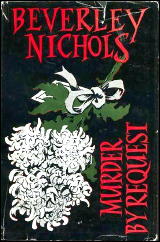
No Man’s Street, Beverley Nichols’ first novel featuring Horatio Green, retired private detective, I found not too impressive.
The plot was good, but it seemed to me that Nichols, having an impressive background as a mainstream novelist, was just toying with the mystery form. In that [first] case, Green was merely a bundle of idiosyncrasies.
With Nichols’ second mystery, The Moonflower (published in the U.S. as The Moonflower Mystery), Green, probably because of the horticultural background, his avocation, comes alive and retains that attribute through the following three novels in the series.
In this, the last of his investigations after his “retirement” at approximately age sixty, Green is invited by Sir Owen Kent, famous financier, to Harmony Hall, the foremost Nature Cure establishment in England. Kent will be spending the Christmas season there himself, and he has received, in the most astonishing ways, threats on his life.
The threatener succeeds in his or her threat, Kent being shot in a room where there are sixteen people, but no one sees the murderer.
A baffling crime, a bit too much even for Green, but when the investigation starts slowing down, fresh clues, reminiscent of those in a mystery novel, pop up. The publishers say that the murderer “is the last person whom even the most hardened expert in whodunits would expect.”
I would differ. Still, it’s a fascinating case.
— From The MYSTERY FANcier, Vol. 11, No. 4, Fall 1989 (very slightly revised).
Bio-Bibliographic Notes: John Beverley Nichols (1898-1983) was a multi-talented man. According to Wikipedia, he was “an author, playwright, journalist, composer, and public speaker,” with substantial credentials provided in each category to prove it.
From the same source, “Nichols is now best remembered for his gardening books, the first of which, Down the Garden Path, […] has been in print almost continuously since first published in 1932.”
The Horatio Green series —
1. No Man’s Street (1954)
2. The Moonflower (1955) (aka The Moonflower Murder, US)
3. Death to Slow Music (1956)
4. The Rich Die Hard (1957)
5. Murder by Request (1960)
« Previous Page — Next Page »





